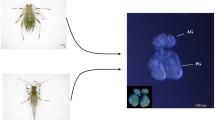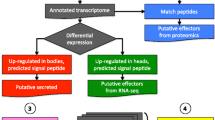Abstract
The brown citrus aphid, Aphis citricidus, stands out as an important citrus pest that is an efficient vector for Citrus tristeza virus (CTV), the causal agent of important economic losses in citrus. Evidence suggests that aphids deliver salivary effector proteins inside their host cells to modulate plant physiology, suppress defense responses, and consequently favor the establishment and infestation. This study employed deep sequencing of RNA libraries to create a transcriptome of the salivary gland. Screening the transcriptome identified 115 unigenes encoding putatively secreted effector proteins. Eleven A. citricidus effectors exhibiting relatively low sequence identities were selected for gene expression analysis. Among them, six effectors (i.e., AcE1, AcE2, AcE3, AcE5, AcE8, and AcE9) displayed remarkably high expression levels in the head with salivary glands; AcE4 was highly expressed in both head and gut tissue. Further transient overexpression revealed that AcE4 could effectively inhibit INF1/BAX-induced leaf chlorosis in Nicotiana benthamiana leaves, implying its potential role in inhibiting plant defense mechanisms against aphid feeding. The findings of this study demonstrate the in silico identification of effector proteins from A. citricidus. Further investigation and analysis of these effectors, like as AcE4, will provide valuable knowledge regarding the molecular mechanisms that govern the interaction between aphids and plants.






Similar content being viewed by others
Data availability
All relevant data are within the manuscript and its additional files.
References
Atamian HS, Chaudhary R, Cin VD, Bao E, Girke T, Kaloshian I (2013) In planta expression or delivery of potato aphid Macrosiphum euphorbiae effectors Me10 and Me23 enhances aphid fecundity. Mol Plant-Microbe Interact 26:67–74
Ayala-Ortiz CO, Farriester JW, Pratt CJ, Goldkamp AK, Matts J, Hoback WW, Gustafson JE, Hagen DE (2021) Effect of food source availability in the salivary gland transcriptome of the unique burying beetle Nicrophorus pustulatus (Coleoptera: Silphidae). PLoS ONE 16:e0255660
Bos JI, Prince D, Pitino M, Maffei ME, Win J, Hogenhout SA (2010) A functional genomics approach identifies candidate effectors from the aphid species Myzus persicae (green peach aphid). PLoS Genet 6:e1001216
Carolan JC, Caragea D, Reardon KT, Mutti NS, Dittmer N, Pappan K, Cui F, Castaneto M, Poulain J, Dossat C (2011) Predicted effector molecules in the salivary secretome of the pea aphid (Acyrthosiphon pisum): a dual transcriptomic/proteomic approach. J Proteome Res 10:1505–1518
Chen CY, Liu YQ, Song WM, Chen DY, Chen FY, Chen XY, Chen ZW, Ge SX, Wang CZ, Zhan S (2019) An effector from cotton bollworm oral secretion impairs host plant defense signaling. Proc Natl Acad Sci USA 116:14331–14338
Dawson WO, Garnsey SM, Tatineni S, Folimonova SY, Harper SJ, Gowda S (2013) Citrus tristeza virus–host interactions. Front Microbiol 4:88
Dong Y, **g M, Shen D, Wang C, Zhang M, Liang D, Nyawira KT, **a Q, Zuo K, Wu S (2020) The mirid bug Apolygus lucorum deploys a glutathione peroxidase as a candidate effector to enhance plant susceptibility. J Exp Bot 71:2701–2712
Dong Y, Huang X, Yang Y, Li J, Zhang M, Shen H, Ren Y, Li X, Tian J, Shen D (2022) Characterization of salivary secreted proteins that induce cell death from Riptortus pedestris (Fabricius) and their roles in insect–plant interactions. Front Plant Sci 13:912603
Du H, Xu HX, Wang F, Qian LX, Liu SS, Wang XW (2022) Armet from whitefly saliva acts as an effector to suppress plant defences by targeting tobacco cystatin. New Phytol 234:1848–1862
Huang HJ, Zhang CX, Hong XY (2019) How does saliva function in planthopper–host interactions? Arch Insect Biochem Physiol 100:e21537
Huang HJ, Ye ZX, Lu G, Zhang CX, Chen JP, Li JM (2021) Identification of salivary proteins in the whitefly Bemisia tabaci by transcriptomic and LC–MS/MS analyses. Insect Sci 28:1369–1381
Ji R, Fu J, Shi Y, Li J, **g M, Wang L, Yang S, Tian T, Wang L, Ju J (2021) Vitellogenin from planthopper oral secretion acts as a novel effector to impair plant defenses. New Phytol 232:802–817
Jones AC, Felton GW, Tumlinson JH (2022) The dual function of elicitors and effectors from insects: reviewing the ‘arms race’ against plant defenses. Plant Mol Biol 109:427–445
Kamoun S, Van West P, Vleeshouwers VG, De Groot KE, Govers F (1998) Resistance of Nicotiana benthamiana to Phytophthora infestans is mediated by the recognition of the elicitor protein INF1. Plant Cell 10:1413–1425
Kim KT, Jeon J, Choi J, Cheong K, Song H, Choi G, Kang S, Lee YH (2016) Kingdom-wide analysis of fungal small secreted proteins (SSPs) reveals their potential role in host association. Front Plant Sci 7:186
Kuang Y, **ong Y, Chen XD, Yu X (2022) Antennae-abundant expression of candidate cytochrome P450 genes associated with odorant degradation in the asian citrus psyllid, Diaphorina citri. Front Physiol 13:1004192
Kuang Y, Shangguan C, Yuan S, Zhang Q, Qiu Z, Gao L, Yu X (2023) Candidate odorant-binding protein and chemosensory protein genes in the turnip aphid Lipaphis erysimi. Arch Insect Biochem Physiol 113:e22022
Lacomme C, Santa Cruz S (1999) Bax-induced cell death in tobacco is similar to the hypersensitive response. Proc Natl Acad Sci USA 96:7956–7961
Livak KJ, Schmittgen TD (2001) Analysis of relative gene expression data using real-time quantitative PCR and the 2−ΔΔCT method. Methods 25:402–408
Lin CH, Bourque G, Tan P (2008) A comparative synteny map of Burkholderia species links large-scale genome rearrangements to fine-scale nucleotide variation in prokaryotes. Mol Biol Evol 25:549–558
Marri PR, Hao W, Golding GB (2006) Gene gain and gene loss in streptococcus: is it driven by habitat? Mol Biol Evol 23:2379–2391
Mutti NS, Louis J, Pappan LK, Pappan K, Begum K, Chen M-S, Park Y, Dittmer N, Marshall J, Reese JC (2008) A protein from the salivary glands of the pea aphid, Acyrthosiphon pisum, is essential in feeding on a host plant. Proc Natl Acad Sci USA 105:9965–9969
Naessens E, Dubreuil G, Giordanengo P, Baron OL, Minet-Kebdani N, Keller H, Coustau C (2015) A secreted MIF cytokine enables aphid feeding and represses plant immune responses. Curr Biol 25:1898–1903
Nicolis VF, Burger NFV, Botha A-M (2022) Whole-body transcriptome mining for candidate effectors from Diuraphis noxia. BMC Genom 23:493
Pelosi P, Iovinella I, Zhu J, Wang G, Dani FR (2018) Beyond chemoreception: diverse tasks of soluble olfactory proteins in insects. Biol Rev 93:184–200
Peng X, Qu M, Wang S, Huang Y, Chen C, Chen M (2021) Chemosensory proteins participate in insecticide susceptibility in Rhopalosiphum padi, a serious pest on wheat crops. Insect Mol Biol 30:138–151
Peng Z, Su Q, Ren J, Tian L, Zeng Y, Yang Y, Wang S, **e W, Wu Q, Li Z, Zhang Y (2023) A novel salivary effector, BtE3, is essential for whitefly performance on host plants. J Exp Bot 74:2146–2159
Prajapati VK, Varma M, Vadassery J (2020) In silico identification of effector proteins from generalist herbivore Spodoptera litura. BMC Genom 21:819
Rajarapu SP, Ben-Mahmoud S, Benoit JB, Ullman DE, Whitfield AE, Rotenberg D (2022) Sex-biased proteomic response to tomato spotted wilt virus infection of the salivary glands of Frankliniella occidentalis, the western flower thrips. Insect Biochem Mol Biol 149:103843
Rao W, Zheng X, Liu B, Guo Q, Guo J, Wu Y, Shangguan X, Wang H, Wu D, Wang Z (2019) Secretome analysis and in planta expression of salivary proteins identify candidate effectors from the brown planthopper Nilaparvata lugens. Mol Plant Microbe Interact 32:227–239
Rodriguez PA, Escudero-Martinez C, Bos JI (2017) An aphid effector targets trafficking protein VPS52 in a host-specific manner to promote virulence. Plant Physiol 173:1892–1903
Serteyn L, Francis F (2019) Insight into salivary gland proteomes of two polyphagous stink bugs: Nezara viridula L. and Halyomorpha halys Stål. Proteomics 19:1800436
Shangguan X, Zhang J, Liu B, Zhao Y, Wang H, Wang Z, Guo J, Rao W, **g S, Guan W (2018) A mucin-like protein of planthopper is required for feeding and induces immunity response in plants. Plant Physiol 176:552–565
Shilts T, El-Mohtar C, Dawson WO, Killiny N (2020) Citrus tristeza virus P33 Protein is required for efficient transmission by the aphid Aphis (Toxoptera) citricidus (Kirkaldy). Viruses 12:1131
Van Bel AJ, Will T (2016) Functional evaluation of proteins in watery and gel saliva of aphids. Front Plant Sci 7:1840
Wang W, Dai H, Zhang Y, Chandrasekar R, Luo L, Hiromasa Y, Sheng C, Peng G, Chen S, Tomich JM (2015) Armet is an effector protein mediating aphid–plant interactions. FASEB J 29:2032–2045
Wang D, Zhang DD, Song J, Li JJ, Wang J, Li R, Klosterman SJ, Kong ZQ, Lin FZ, Dai XF (2022) Verticillium dahliae CFEM proteins manipulate host immunity and differentially contribute to virulence. BMC Biol 20:55
Wu J, Baldwin IT (2010) New insights into plant responses to the attack from insect herbivores. Annu Rev Genet 44:1–24
Xu HX, Qian LX, Wang XW, Shao RX, Hong Y, Liu SS, Wang XW (2019) A salivary effector enables whitefly to feed on host plants by eliciting salicylic acid-signaling pathway. Proc Natl Acad Sci USA 116:490–495
Yu X, Killiny N (2018) The secreted salivary proteome of Asian citrus psyllid Diaphorina citri. Physiol Entomol 43:324–333
Yu X, Wang G, Huang S, Ma Y, **a L (2014) Engineering plants for aphid resistance: current status and future perspectives. Theor Appl Genet 127:2065–2083
Yu XD, Liu ZC, Huang SL, Chen ZQ, Sun YW, Duan PF, Ma YZ, **a LQ (2016) RNAi-mediated plant protection against aphids. Pest Manag Sci 72:1090–1098
Yu X, Marshall H, Liu Y, **ong Y, Zeng X, Yu H, Chen W, Zhou G, Zhu B, Ross L, Lu Z (2023) Sex-specific transcription and DNA methylation landscapes of the Asian citrus psyllid, a vector of huanglongbing pathogens. Evolution 77:1203–1215
Zhang Y, Liu X, Francis F, **e H, Fan J, Wang Q, Liu H, Sun Y, Chen J (2022a) The salivary effector protein Sg2204 in the greenbug Schizaphis graminum suppresses wheat defence and is essential for enabling aphid feeding on host plants. Plant Biotechnol J 20:2187–2201
Zhang Y, Liu X, Fu Y, Crespo-Herrera L, Liu H, Wang Q, Zhang Y, Chen J (2022b) Salivary effector Sm9723 of grain aphid Sitobion miscanthi suppresses plant defense and is essential for aphid survival on wheat. Int J Mol Sci 23:6909
Zhang Y, Fu Y, Liu X, Francis F, Fan J, Liu H, Wang Q, Sun Y, Zhang Y, Chen J (2023) SmCSP4 from aphid saliva stimulates salicylic acid-mediated defence responses in wheat by interacting with transcription factor TaWKRY76. Plant Biotechnol J 21:2389–2407
Acknowledgements
The authors wish to acknowledge the assistance of **g Zhao, Wenhui Tong, and Sha Ye with the aphid samples.
Funding
This work is funded by the National Natural Science Foundation of China (grant no. 32160634), the Natural Science Foundation for Distinguished Young Scholars of Jiangxi province (grant no. 20212ACB215001), and the Double Thousand Plan of Jiangxi Province (grant no. jxsq2019101058).
Author information
Authors and Affiliations
Contributions
XY conceived the study; CS and YK reared the insects and conducted the laboratory work; XY, CS, YK, and ZC carried out the analyses; XY wrote the manuscript.
Corresponding author
Ethics declarations
Conflict of interest
The authors declare that they have no conflicts of interest.
Additional information
Handling Editor: Hongbo Jiang.
Publisher's Note
Springer Nature remains neutral with regard to jurisdictional claims in published maps and institutional affiliations.
Supplementary Information
Below is the link to the electronic supplementary material.
Rights and permissions
Springer Nature or its licensor (e.g. a society or other partner) holds exclusive rights to this article under a publishing agreement with the author(s) or other rightsholder(s); author self-archiving of the accepted manuscript version of this article is solely governed by the terms of such publishing agreement and applicable law.
About this article
Cite this article
Shangguan, C., Kuang, Y., Chen, Z. et al. Screening candidate effectors from the salivary gland transcriptomes of brown citrus aphid, Aphis citricidus. Arthropod-Plant Interactions (2024). https://doi.org/10.1007/s11829-024-10071-8
Received:
Accepted:
Published:
DOI: https://doi.org/10.1007/s11829-024-10071-8




